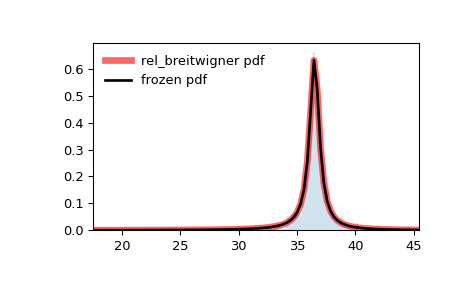本文简要介绍 python 语言中 scipy.stats.rel_breitwigner 的用法。
用法:
scipy.stats.rel_breitwigner = <scipy.stats._continuous_distns.rel_breitwigner_gen object>#相对论Breit-Wigner 随机变量。
作为
rv_continuous类的实例,rel_breitwigner对象从它继承了一组通用方法(完整列表见下文),并用特定于此特定发行版的详细信息来完成它们。注意:
rel_breitwigner的概率密度函数为其中
相对论Breit-Wigner 分布在高能物理学中用于模拟共振 [1]。它给出了具有特征质量 和 decay-width 的共振的不变质量 [2] 的不确定性,其中 、 和 以自然单位表示。在 SciPy 的参数化中,形状参数 等于 并采用 中的值。
同样,相对论Breit-Wigner分布据说给出了center-of-mass能量的不确定性。在自然单位中,光速等于1,不变质量等于静止能量。在center-of-mass帧中,剩余能量等于总能量[3]。
上面的概率密度在“standardized” 表格中定义。要移动和/或缩放分布,请使用
loc和scale参数。具体来说,rel_breitwigner.pdf(x, rho, loc, scale)等同于rel_breitwigner.pdf(y, rho) / scale和y = (x - loc) / scale。请注意,移动分布的位置不会使其成为“noncentral” 分布;某些分布的非中心概括可在单独的类中获得。和 是比例参数。例如,如果想要用 和 [4] 建模 玻色子,可以设置
rho=91.1876/2.4952和scale=2.4952。为了确保在使用
fit方法时获得物理上有意义的结果,应设置floc=0将位置参数固定为 0。参考:
[1]相对论 Breit-Wigner 分布,维基百科,https://en.wikipedia.org/wiki/Relativistic_Breit-Wigner_distribution
[2][3]Center-of-momentum 框架,维基百科,https://en.wikipedia.org/wiki/Center-of-momentum_frame
[4]M.Tanabashi 等人。 (粒子数据组)物理。 Rev. D 98, 030001 - 2018 年 8 月 17 日发布
例子:
>>> import numpy as np >>> from scipy.stats import rel_breitwigner >>> import matplotlib.pyplot as plt >>> fig, ax = plt.subplots(1, 1)计算前四个时刻:
>>> rho = 36.5 >>> mean, var, skew, kurt = rel_breitwigner.stats(rho, moments='mvsk')显示概率密度函数(
pdf):>>> x = np.linspace(rel_breitwigner.ppf(0.01, rho), ... rel_breitwigner.ppf(0.99, rho), 100) >>> ax.plot(x, rel_breitwigner.pdf(x, rho), ... 'r-', lw=5, alpha=0.6, label='rel_breitwigner pdf')或者,可以调用分布对象(作为函数)来固定形状、位置和比例参数。这将返回一个 “frozen” RV 对象,其中包含固定的给定参数。
冻结分布并显示冻结的
pdf:>>> rv = rel_breitwigner(rho) >>> ax.plot(x, rv.pdf(x), 'k-', lw=2, label='frozen pdf')检查
cdf和ppf的准确性:>>> vals = rel_breitwigner.ppf([0.001, 0.5, 0.999], rho) >>> np.allclose([0.001, 0.5, 0.999], rel_breitwigner.cdf(vals, rho)) True生成随机数:
>>> r = rel_breitwigner.rvs(rho, size=1000)并比较直方图:
>>> ax.hist(r, density=True, bins='auto', histtype='stepfilled', alpha=0.2) >>> ax.set_xlim([x[0], x[-1]]) >>> ax.legend(loc='best', frameon=False) >>> plt.show()
相关用法
- Python SciPy stats.relfreq用法及代码示例
- Python SciPy stats.recipinvgauss用法及代码示例
- Python SciPy stats.rayleigh用法及代码示例
- Python SciPy stats.rankdata用法及代码示例
- Python SciPy stats.rv_histogram用法及代码示例
- Python SciPy stats.random_table用法及代码示例
- Python SciPy stats.rvs_ratio_uniforms用法及代码示例
- Python SciPy stats.rice用法及代码示例
- Python SciPy stats.random_correlation用法及代码示例
- Python SciPy stats.ranksums用法及代码示例
- Python SciPy stats.rv_discrete用法及代码示例
- Python SciPy stats.randint用法及代码示例
- Python SciPy stats.rv_continuous用法及代码示例
- Python SciPy stats.rdist用法及代码示例
- Python SciPy stats.anderson用法及代码示例
- Python SciPy stats.iqr用法及代码示例
- Python SciPy stats.genpareto用法及代码示例
- Python SciPy stats.skewnorm用法及代码示例
- Python SciPy stats.cosine用法及代码示例
- Python SciPy stats.norminvgauss用法及代码示例
- Python SciPy stats.directional_stats用法及代码示例
- Python SciPy stats.invwishart用法及代码示例
- Python SciPy stats.bartlett用法及代码示例
- Python SciPy stats.levy_stable用法及代码示例
- Python SciPy stats.page_trend_test用法及代码示例
注:本文由纯净天空筛选整理自scipy.org大神的英文原创作品 scipy.stats.rel_breitwigner。非经特殊声明,原始代码版权归原作者所有,本译文未经允许或授权,请勿转载或复制。
